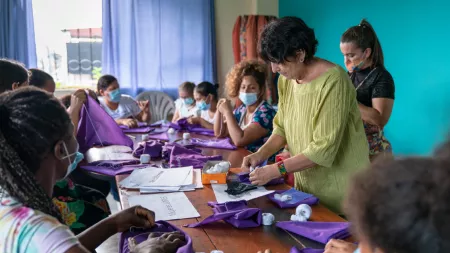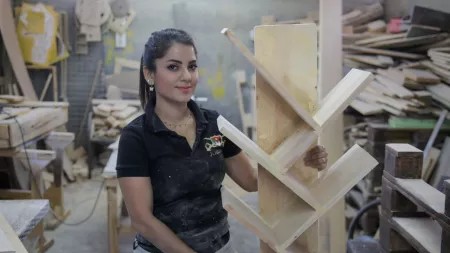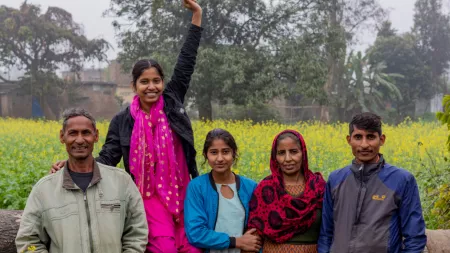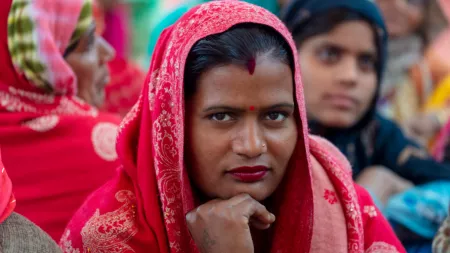CARE has supported 16.5 million women and girls to increase their empowerment & gender equality since 2015. What do we mean by this? More girls and women are speaking out about the issues that affect them, making decisions about their home and family as equals with their partners, working together for change in their communities, accessing services which meet their needs, and so much more.
At CARE, gender equality isn’t just another program. Gender is at the core of our Vision 2030 Strategy and embedded within everything that we do. But more than this, we see women and girls as the driving force able to create a fairer and better world for all. Our approach to Gender Equality programming focuses on reducing gender-based violence (GBV), promoting women’s voice and leadership (WVL), and ensuring access to inclusive education. But beyond this, we intentionally address the root causes of gender inequality by centering gender equality in our programs across all sectors.
Our recently published Gender Equality Annual Report summarizes CARE’s progress towards our goal, highlighting impact data reported in CARE’s Project & Program Information and Impact Reporting System (PIIRS) in FY 2022 (July 2021 – June 2022) and drawing on insights from CARE’s Vision 2030 learning review in 2023.

What we have achieved?
- Women and girls are influencing decisions which affect their lives: 871,000 people were impacted by specific changes related to Women’s Voice and Leadership, including 144,000 women and girls reporting confidence in their own negotiation and communication skills and 101,000 women and girls influencing public decision-making and structural changes in their communities.
- Women and girls at risk of violence feel safer and can access services: 500,000 people have been impacted by specific changes related to gender-based violence. This includes people accessing GBV response services in development and humanitarian settings, and more people condemning violence. In Bangladesh, the Prohori project worked with more than 44,000 people to shift social norms which normalize intimate partner violence. Women reported reduced intimate partner violence and an increased ability to speak up about their rights.
- Girls are overcoming barriers to accessing education and improving their prospects: 735,000 people were impacted by specific changes related to education such as schools addressing the specific needs of girls. In Somalia, more girls are enrolling in school and fewer are dropping out as a result of the Adolescent Girls’ Education in Somalia project (AGES) project, despite the shocks of COVID and the worst drought in 40 years.
- Humanitarian aid is reaching the most vulnerable: 135,000 people in emergency contexts obtained access to lifesaving GBV prevention and response services, while 415,000 people were supported through gender sensitive assistance in the form of cash or vouchers.
- Projects across all sectors are improving gender equality: Nearly 3/4 of CARE projects reporting impact in 2022 – across sectors including health, climate, agriculture and livelihoods – were able to report at least one change related to gender equality. This includes 1,1 million more women able to meet family planning needs, 431,000 more women participating in decisions about agricultural production and household income, 102,000 more women with increased capability to participate equitably in economic activities and 23,000 more women actively participating in climate decision-making spaces.

How did we get here?
- Considering GBV risks across any sector: CARE has made a concerted effort to amplify impact through new guidance addressing gender-based violence in both development and emergency settings. 65% of all CARE programs fully or partially addressed GBV.
- Engaging men and boys for gender equality: We are strengthening our focus on the role of men and boys in promoting gender equality with new guidance to amplify our impact. 80% of all CARE programs fully or partially engaged men and boys.
- Challenging harmful social norms: CARE views the shifting of harmful social norms as key to promoting gender equality, and we are further examining how social norms approaches are improving the lives of women and girls across more sectors. 43% of all CARE programs worked to address social norms.
- Embedding gender best practice in other programs: Our anlaysis showed that combining CARE’s VSLA groups with gender equality programming can create transformative change in social norms, women’s household decision-making, and access to capital. We’re working to expand this across all our savings groups and embed it within other program areas.
- Centering gender in our teams, strategies and processes: Our Go Deeper Initiative is leading commitment to gender at the Country Office level by developing focused gender strategies, increasing opportunities for staff development, shifting internal ways of working and strengthening technical expertise on proven approaches for placing gender at the center of our programs and operations.
- Shifting power to feminist organizations: Programs like Feminists in Action are finding new ways to support women’s rights organizations to strengthen their actions.

Gender equality is an indispensable tool for lasting and deep social transformation. We cannot achieve women’s economic justice, climate justice, health equity, the right to food, water, and nutrition, or equal access to humanitarian assistance without addressing gender inequality. That's why we work towards this purpose in everything we do.
Read more